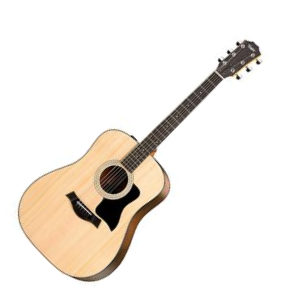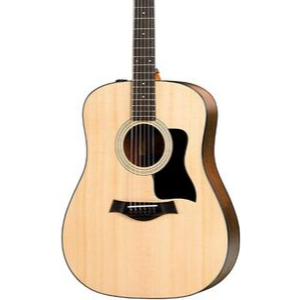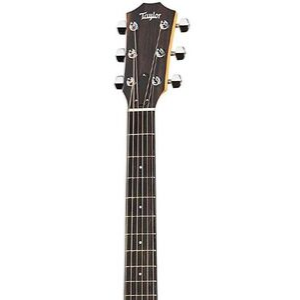- Home
- Instruments
- Gear
- Recording
- Lessons
- Reviews
- Blog


| Body And Neck: |  |
| Hardware: |  |
| Sound: |  |
| Value: |  |
While it’s true that guitar manufacturers are producing higher quality models in the budget range than they had in the past, there is still a stigma of an entry-level model not being good enough to be your go-to guitar. The Taylor 110e is a prime example of a lower-cost model that can go to battle with much of the higher-priced competition.
 Body and Neck
Body and NeckThe dreadnought body shape is a classic, and the 110e pulls it off very well. Many starter models feature a laminated top, but here you have one made from solid Sitka spruce, which helps for better vibration transfer and resonation. The back and sides are made from laminated walnut, resulting in an overall durable construction meant for excellent tone projection.
Taylor uses hard rock maple for the neck material, which is an excellent tonewood choice. Adding to the quality construction is a true ebony fingerboard that houses 20 frets, along with single dot fret-marker inlays. There’s no fancy binding to be found here, but there is still an air of elegance thanks to the trademark Taylor headstock design.

Sure, many starter-level model guitars have all kinds of hardware features these days, but what you’ll find on the 110e may be a touch above the pack.
Starting things off is the Expression System 2 (ES2) pickup design. Most acoustics that have electric capability use piezo elements that are mounted underneath the bridge saddle. The ES2 is unique in that the elements are mounted behind the bridge instead of directly under it, which Taylor has found to be a better method for transferring the guitar’s vibrations.
The chrome Taylor tuners are as you would expect from the brand, with smooth action that makes fine adjustments easy and accurate, and the addition of a Taylor soft gig bag helps to protect your investment. Admittedly, though, having the harder-wall gig bag that comes with their more expensive models would have been a better choice.
And lastly, it’s a typical Taylor hallmark to not have an onboard tuner (the ES2 preamp has only three knobs: a 2-band EQ and volume), but that can be resolved by using a good clip-on tuner instead.
Taylor has a top-shelf reputation to uphold, so the level of sound quality that the 110e provides shouldn’t be a surprise. When playing unplugged, the sound is well balanced, with lows that aren’t too boomy and high notes that cut through at just the right volume.
Plugged in, the 110e can be borderline glorious thanks to the ES2 system. Many acoustic-electric guitars have a thin sound that is typical of piezo pickup designs. With the relocation of the elements behind the bridge, most piezo squawk is held to a minimum, resulting in a more balanced and natural sound.
Playability is just as should be expected from a Taylor, with the action being very comfortable when playing barre chords at lower frets along with single-line runs that seem to take little effort. We dare say you’d be hard-pressed to tell this acoustic-electric guitar is in the under $1,000 price range.
All in all, the 110e is an excellent gateway into the Taylor model lineup. Granted, it may cost a little more than many of the ‘beginner’ guitars on the market today, but we think that the build quality and tonal capability of this guitar easily justifies the difference.
For more info about the Taylor 110e, click here.
For more of the best acoustic guitars under $1,000, click here.

Reader Interactions